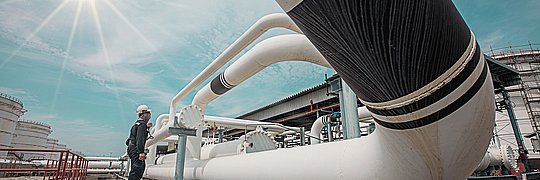
Biomethane transportation
-
Priority grid connection
According to Section 33 GasNZV, grid operators at all pressure levels are obliged to give priority to connecting systems to the gas grid immediately upon request. The costs for the grid connection are borne by the grid operator (75 percent) and the biogas feeder (25 percent) on a pro rata basis up to ten kilometers of connecting pipeline. The costs for the grid connection and the first kilometer of the connecting pipeline are capped at a maximum of €250,000 for the biogas feeder. The grid operator cannot refuse the feed-in of biogas in accordance with Section 34 (2) sentence 2 GasNZV with reference to existing capacity bottlenecks in the grid. Grid operators and biogas feeders should agree on an implementation schedule for the establishment of the grid connection in accordance with Section 33 (7) GasNZV, which will be submitted to the Federal Network Agency. The grid operator is the owner of the grid connection and bears the costs for maintenance and operation.
Priority network access
According to Section 34 GasNZV, network operators must give priority to concluding entry and exit contracts with biomethane transport customers, provided that these gases are compatible with the network. At the same time, the network operator is obliged to make all economically reasonable efforts to optimize the technical capacity of the network and ensure an availability of at least 96 percent.
Extended balancing
For biogas transport customers, Section 35 GasNZV provides for special regulations on extended balancing in biogas balancing. While the network operator only has to offer unremunerated balancing within narrow hourly tolerance limits for natural gas transport customers within the balancing group, it is obliged to offer a flexibility framework of 25 percent for exclusive biogas balancing groups.
The flexibility framework applies for the special biogas balancing period of twelve months. Within this balancing period, the flexibility framework refers to the cumulative deviation of the quantity fed in from the quantity fed out. A flat-rate fee of 0.1 ct/kWh must be paid to the grid operator for the use of the flexibility framework actually utilized.
-
The worksheets of the German Technical and Scientific Association for Gas and Water (DVGW) define the basic requirements for gases in public supply networks. The basis for the quality of gases from renewable sources is DVGW Code of Practice G 262. If the biogas produced is to be fed into the public gas network, it must comply with the requirements of DVGW Code of Practice G 260 and in particular meet the requirements of the second gas family with the group available on site.
DVGW worksheet G 265-1 summarizes the minimum requirements for the planning, manufacture, construction, testing and commissioning of biogas upgrading and feed-in systems. It contains the specifications for the technical safety of the plants and their components required for the utilization of biogas - from the processing plant to compression, pressure regulation, conditioning and measurement through to feeding into the gas network as additional or replacement gas. The recently revised DVGW Code of Practice G 415 contains the minimum requirements for the planning, construction and operation of gas pipelines up to 5 bar operating pressure in which raw biogas or partially treated biogas is conveyed. DVGW Code of Practice G 1030 specifies the requirements for the qualification and organization of operators of systems used to produce, transport, treat, condition or feed in biogas. It therefore contains the specifications for a technical safety management system (TSM) for biogas plants.
-
The EU Gas Market Framework Directive was published in draft form in September 2021.The Gas Market Directive distinguishes between “natural gas”, “renewable gas”, “low-carbon gas” and “low-carbon hydrogen”. It places a strong focus on hydrogen. In order to further promote the defossilization of the gas grid, discounts of at least 75% on the transport fees for renewable and low-carbon gases to and from storage and generation facilities are planned.